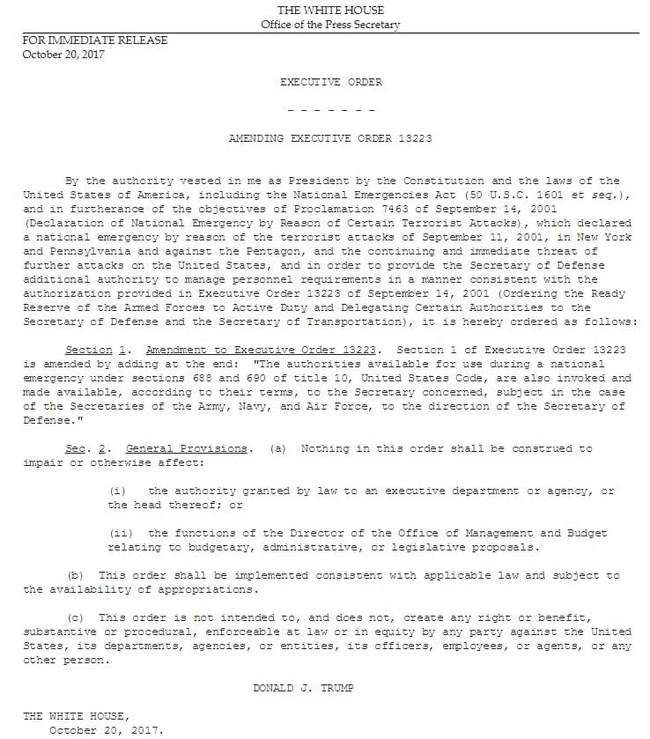
One of the 4 B-52 bombers from the 917th Reserve Wing at Barksdale Air force Base in Louisiana lands at Elmendorf Air Force Base in Anchorage, Alaska Wednesday, June 9, 1999, to take part in the Cope Thunder exercise. The two-week airpower exercise, begins on Thursday. The 917th is the only Air Force Reserve B-52 squadron. (AP Photo/Al Grillo)
Several disparate threads came together over the weekend and what it means may or may not be significant.
Flashback to the early October story that Trump demanded a ‘tenfold’ increase in the number of US nuclear weapons and that Rex Tillerson called Trump a ‘f***ing moron’ in response. That meeting took place on July 27 and a significant subject in the meeting held in The Tank, that is, the Joint Chiefs of Staff briefing room, was modernization of the nuclear triad. If you aren’t familiar with the concept, it is that to truly have a deterrent effect the nuclear arsenal must be divided between submarine-based ICBMs, land-based ICBMs, and strategic bombers. This ensures that even in the event of a successful, Pearl-Harbor-style, pre-emptive attack on the United States, it would be impossible for that strike to eliminate a nuclear counter-strike.
Last Friday afternoon, that media dead zone where you dump information you’d rather have ignored, the White House released this:

What this does is permit the military branches to recall to active duty as many retirees as they can afford under manpower caps. Otherwise, each service only has the authority to have, IIRC, 25 retirees recalled to the colors on the books.
This seemed strange. The people you are recalling to active duty from retirement are going to be senior officers (lieutenant colonel and colonels) who will be about 50 (average retiring officer is a lieutenant colonel with 27 years of service, so age 49 at retirement) or senior non-commissioned officers in their mid-40s. During the early days of our response to 9/11, retirees were assigned administrative billets at installations and on staffs to free up active duty personnel to deploy.
What’s going on? The immediate speculation ran to war with North Korea being imminent but recalling up retirees in advance of the act isn’t something that I’d consider particularly bright…assuming bright is something that appeals to you. Shortly after the EO, this ran.
President Trump signed an executive order Friday allowing the Air Force to recall as many as 1,000 retired pilots to active duty to address a shortage in combat fliers, the White House and Pentagon announced.
…
The Air Force needs about 1,500 pilots more than it has. Bonus programs and other incentives have not made up the shortfall.The Air Force has been at the forefront of the Pentagon’s battle against the Islamic State, flying most of the combat sorties in Iraq and Syria since 2014.
In June, Sen. John McCain, R-Ariz., labeled the pilot shortage a crisis that would prevent the Air Force from fulfilling its mission.
“This is a full-blown crisis, and if left unresolved, it will call into question the Air Force’s ability to accomplish its mission,” said McCain, chairman of the Armed Services Committee.
Richard Aboulafia, an aviation analyst and vice president of the Teal Group, said the shortage stemmed from a number of issues.
“One is competition from commercial airlines,” Aboulafia said. “Another is delays and funding shortfalls in training. And, due to military operations, utilization of the aircraft and crew has been higher than expected.”
One has to wonder how a service which has nearly 320,000 people on active duty and its entire raison d’être is flying airplanes finds itself short 1,500 pilots, but it is what it is.
Then, over the weekend, this story ran and it is where the first item comes in:
The U.S. Air Force is preparing to put nuclear-armed bombers back on 24-hour ready alert, a status not seen since the Cold War ended in 1991.
That means the long-dormant concrete pads at the ends of this base’s 11,000-foot runway — dubbed the “Christmas tree” for their angular markings — could once again find several B-52s parked on them, laden with nuclear weapons and set to take off at a moment’s notice.
“This is yet one more step in ensuring that we’re prepared,” Gen. David Goldfein, Air Force chief of staff, said in an interview during his six-day tour of Barksdale and other U.S. Air Force bases that support the nuclear mission. “I look at it more as not planning for any specific event, but more for the reality of the global situation we find ourselves in and how we ensure we’re prepared going forward.”
Goldfein and other senior defense officials stressed that the alert order had not been given, but that preparations were under way in anticipation that it might come. That decision would be made by Gen. John Hyten, the commander of U.S. Strategic Command, or Gen. Lori Robinson, the head of U.S. Northern Command. STRATCOM is in charge of the military’s nuclear forces and NORTHCOM is in charge of defending North America.
Putting the B-52s back on alert is just one of many decisions facing the Air Force as the U.S. military responds to a changing geopolitical environment that includes North Korea’s rapidly advancing nuclear arsenal, President Trump’s confrontational approach to Pyongyang, and Russia’s increasingly potent and active armed forces.
So, it seems, one of the items being discussed in July was this move. On paper, the strategy hinted at by the EO makes sense. Among retired aviators there will be guys with a lot of hours on the BUFF and will be ready for duty after an accelerated refresher course. It would also to the USAF training base to focus on training pilots for higher density airframes, like the f-16, F-35, etc. Another beneficiary would obviously be the A-10 community. The training base would also benefit by releasing active duty officers and replacing them with very experienced, recently retired guys. But the obvious focus of the program is to support the return of B-52s to alert status.
The bigger question is why this move is actually necessary. North Korea’s nuclear arsenal does not have the ability to wipe out our land-based or submarine-based ICBM forces. The kerfuffle with Robert Mueller aside, I don’t think a serious person can claim that Russia is anything more than a troublesome regional power with a legacy inventory of nuclear weapons that may or may not work. Keeping a number of B-52s in readiness for immediate launch, containing nuclear weapons, is a complex, expensive and labor intensive effort. If you are down 1,500 pilots and your a flying missions in Afghanistan, Syria/Iraq, the Persian Gulf and you are looking at North Korea on the horizon, this would be one helluva time to resume the strip alert mission.
This leads one to wonder whether the change in alert status is real or a smokescreen. If war with Korea is a possibility, the USAF doesn’t want to go to war short 1,500 pilots in a theater where airpower is going to be critical and where length of missions is going to deplete the number of available pilots because of rest requirements. Bomber crews, for instance, are allowed to log 84 flight hours every 30 days–flight time lasts from mission briefing to engine shutdown. The safety regs can be waived but it is not a cost-free decision. Bringing 1,000 recently retired and highly experienced pilots back on active duty would be a very logical choice to make.














Join the conversation as a VIP Member